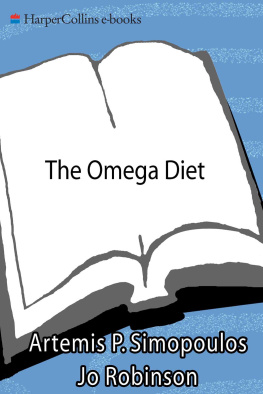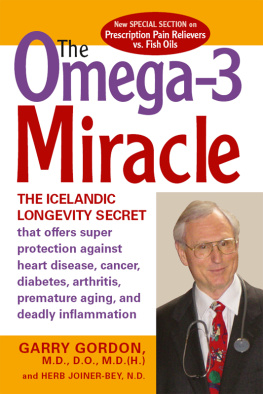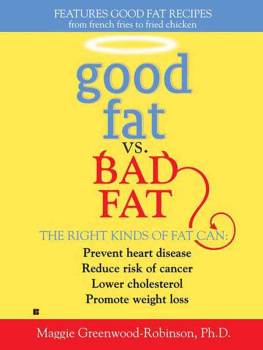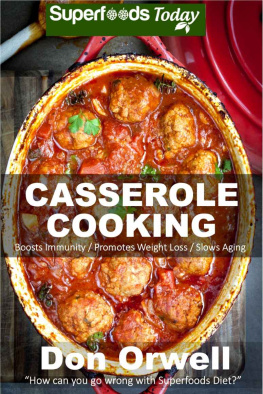To my husband, Alan Lee Pinkerson, M.D., and my daughters, Daphne, Lee, and Alexandra Pinkerson, M.D., whose enthusiasm and support encouraged me to translate the latest nutrition knowledge and concepts into a book for the benefit of the general public
A.P.S.
In this book, I have the privilege of presenting some lifesaving new discoveries about diet and health. Careful research conducted over the past fifteen years has shown that fat is more than fuelit is an essential nutrient that influences every aspect of your being from your ability to learn to the beating of your heart. Whether fat enhances or undermines your health depends on its unique blend of fatty acids, the molecular building blocks of fats and oils. Eating a healthy balance of fatty acids will reduce your risk of a host of diseases, including cardiovascular disease, cancer, diabetes, obesity, arthritis, and asthma. It might even save your life.
In an ideal world, we should not have to know anything about fatty acids in order to eat a healthy diet; we should be able to shop at the local store, buy products that are readily available, and be confident that we are bringing home nutritionally balanced food. But we do not have this luxury. Unwittingly, we have allowed the food industry to make technological changes to our food supply without understanding the biological consequences. The net result is that our diet is so different from the natural human diet, the diet on which our species evolved, that it is at odds with our genetic makeup, increasing our risk of heart disease, cancer, diabetes, obesity, and immune disorders. The Omega Diet , the landmark medically proven program featured in this book, restores a healthy balance of essential nutrients to your diet. This simple and delicious program will help every cell and every system in your body function as nature intended.
As fortune would have it, I grew up eating a diet very similar to The Omega Diet. I was born in Greece, a country with a 5,000-year tradition of good nutrition. My mother made a great effort to give us fresh, wholesome food, a task made easier by the fact that we had a large estate that had been in her family for generations. Within the stone walls of the estate were chickens, goats, sheep, and hundreds of trees that gave us olives, pears, figs, plums, and pomegranates. The mild climate allowed fruits and vegetables to grow year round. Given this bounty, everything we ate was impeccably fresh. The eggs that went into the spinach pie had been laid by our hens that very morning. The milk was from the days first milking. The whole-wheat bread was freshly made, and the olive oil that anointed the bread had been pressed from our own olives. For lunch, we had charcoal-broiled fish that had been swimming in the Mediterranean Sea only the day before. One of my childhood delights was waking up in the morning and hurrying down to breakfast, knowing that I would be greeted by a bowl of ripe fruit. The fruit would be chillednot because it had come from the refrigerator but because it had been picked before dawn.
Although the food was delicious and bountiful, it was eaten with restraint. As is true in most Greek households, a period of fasting preceded our holidays and feast days. During Lent, for example, we would go for several weeks without eating meat or dairy products. During Easter week, we would even forgo olive oil. It wasnt unusual for adults to lose ten pounds before Easter, a reversal of the American tradition of feasting during the holidays and then going on a punishing diet. Exercise was an integral part of our lives. We would walk to market, to school, and to church. In church, everyone would stand except the old people. In school, we had a full hour of physical activity every day. People from the wealthiest families even had personal exercise trainersdecades before the practice became fashionable in the United States.
I was in for a rude shock when I came to the United States in 1949 to study chemistry at Barnard College. To put it bluntly, I found much of the food inedible. I can still remember the first breakfast I ate in the dorm. The only bread available was white bread, which, to me, tasted like cotton. There was one kind of cheese, an intensely orange, bland, and rubbery cheese. The fruit looked appetizing, but it had so little flavor that it was hard to believe it was the same kind of fruit that grew in Greece. There were three other Greek students at Barnard, and they viewed the American diet with equal dismay. Eventually, we discovered that white bread tastes better when its toasted, and that rye crackers are a reasonable stand-in for whole-grain bread.
The stark contrast between the American diet of the 1950s and the traditional Greek diet made such an impression on me that it helped shape my entire medical career. When I went to medical school, I specialized in pediatrics and focused much of my attention on infant and maternal nutrition. I began to realize that many of the children with serious diseases had been malnourished in the womb. This unfortunate start was made worse by the types of food eaten in the homerefined foods, lots of saturated fat and sugar, very few fruits and vegetables, and margarine with its hidden cargo of trans-fatty acids. My first job following my training was directing the newborn nursery at George Washington University, and I saw once again that diet and lifestyle can have dramatic effects on the health of the child. This observation made me interested in the interplay between genetics and nutrition as well. Which types of food were ideally suited for a childs genetic background? How could diet help compensate for genetic defects? I found the answers to many of my questions when I went to study endocrinology and metabolism at the National Institutes of Health (NIH).
In the late 1970s and 1980s, I added another interestfood politics. Medical research alone cannot change what Americans eat. Vital research paid for with taxpayers money remains locked in the medical journals unless it is communicated to the public and implemented by government policy. To help shape that policy, I chaired the Nutrition Coordinating Committee at the NIH for nine consecutive years and co-chaired the Interagency Committee for Human Nutrition Research at the Office of Science and Technology Policy at the White House for five years. These committees influenced nutrition and food policy throughout the federal government.
While chairing the committees, I became aware of a number of new findings about essential fatty acids and, in 1985, helped organize the first international conference devoted exclusively to this topic. Following the conference, my colleagues and I wrote a comprehensive research program focusing on essential fatty acids that was adopted by ten separate institutes of the NIH.
One of the most important findings to come out of the research program is that our bodies function most efficiently when we eat fats that contain a balanced ratio of the two families of essential fatty acidsomega-6 and omega-3 fatty acids. The ratio in the typical American diet has been estimated to be as high as 20 to 1. One of the few diets in the world to have a balanced ratio of essential fatty acids is the traditional Greek diet. Ironically, I had spent much of my medical career gaining scientific insight into the very diet on which I was raised.
When you follow The Seven Dietary Guidelines of The Omega Diet, you will be fueling your body with a ratio of essential fatty acids ideally suited for your metabolism. You will also be enriching your diet with fresh fruit, vegetables, legumes, and oils high in omega-3 fatty acids. A study conducted in the 1990s (the Lyon Diet Heart Study) demonstrated convincingly that this type of diet protects your cardiovascular system more effectively than any other heart diet or drug.






